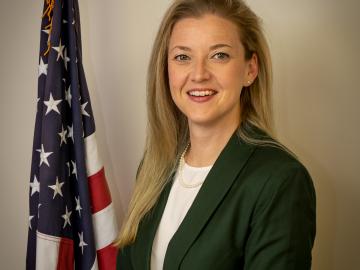Filter News
Area of Research
- Advanced Manufacturing (8)
- Biology and Environment (37)
- Building Technologies (1)
- Clean Energy (70)
- Computational Biology (1)
- Computational Engineering (2)
- Computer Science (4)
- Electricity and Smart Grid (1)
- Fusion and Fission (15)
- Fusion Energy (1)
- Isotopes (13)
- Materials (17)
- Materials for Computing (18)
- Mathematics (1)
- National Security (9)
- Neutron Science (17)
- Nuclear Science and Technology (1)
- Quantum information Science (3)
- Sensors and Controls (1)
- Supercomputing (21)
- Transportation Systems (1)
Date
News Topics
- 3-D Printing/Advanced Manufacturing (36)
- Advanced Reactors (5)
- Artificial Intelligence (29)
- Big Data (11)
- Bioenergy (23)
- Biology (34)
- Biomedical (15)
- Biotechnology (10)
- Buildings (25)
- Chemical Sciences (18)
- Clean Water (11)
- Climate Change (29)
- Composites (10)
- Computer Science (46)
- Coronavirus (10)
- Critical Materials (7)
- Cybersecurity (5)
- Decarbonization (26)
- Education (1)
- Emergency (1)
- Energy Storage (30)
- Environment (57)
- Exascale Computing (7)
- Fossil Energy (2)
- Frontier (10)
- Fusion (12)
- Grid (16)
- High-Performance Computing (32)
- Isotopes (21)
- ITER (5)
- Machine Learning (9)
- Materials (45)
- Materials Science (34)
- Mathematics (3)
- Mercury (3)
- Microscopy (12)
- Nanotechnology (12)
- National Security (20)
- Net Zero (6)
- Neutron Science (27)
- Nuclear Energy (12)
- Partnerships (9)
- Physics (5)
- Polymers (10)
- Quantum Computing (13)
- Quantum Science (22)
- Security (5)
- Simulation (10)
- Space Exploration (7)
- Statistics (3)
- Summit (13)
- Sustainable Energy (50)
- Transportation (31)
Media Contacts

An Oak Ridge National Laboratory research team discovered that aspen saplings emerging after wildfire have less diverse microbiomes and more pathogens in their leaves, providing new insights about how fire affects ecosystem recovery.

A team of Oak Ridge National Laboratory researchers demonstrated that an additively manufactured hot stamping die – a tool used to create car body components – cooled faster than those produced by conventional manufacturing methods.

A method developed at Oak Ridge National Laboratory to print high-fidelity, passive sensors for energy applications can reduce the cost of monitoring critical power grid assets.

Twenty-seven ORNL researchers Zoomed into 11 middle schools across Tennessee during the annual Engineers Week in February. East Tennessee schools throughout Oak Ridge and Roane, Sevier, Blount and Loudon counties participated, with three West Tennessee schools joining in.

Stan Wullschleger has been selected as the associate laboratory director for the Biological and Environmental Systems Science Directorate, or BESSD, at ORNL.

Cory Stuart of ORNL applies his expertise as a systems engineer to ensure the secure and timely transfer of millions of measurements of Earth’s atmosphere, fueling science around the world.

Balendra Sutharshan, deputy associate laboratory director for operational systems at DOE’s Pacific Northwest National Laboratory, has joined ORNL as associate laboratory director for the Isotope Science and Engineering Directorate.

Joan Bienvenue has been selected as the first executive director of the Oak Ridge Institute at the University of Tennessee, established last year to align the expertise and infrastructure of Oak Ridge National Laboratory and the university in support of world-leading research and talent development. As director, Bienvenue will also serve as a vice provost at UT. She begins her new position March 8.

For a researcher who started out in mechanical engineering with a focus on engine combustion, Martin Wissink has learned a lot about neutrons on the job

To better understand the spread of SARS-CoV-2, the virus that causes COVID-19, Oak Ridge National Laboratory researchers have harnessed the power of supercomputers to accurately model the spike protein that binds the novel coronavirus to a human cell receptor.




